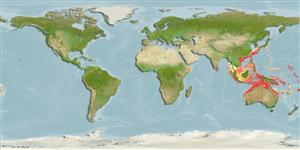>
Mulliformes (Goatfishes) >
Mullidae (Goatfishes)
Etymology: Upeneus: Greek, ypene, -es = upper lip (Ref. 45335); torres: Named for its type locality, Torres Strait (in turn named after Luis Váez de Torres, a 16th-17th century maritime explorer; noun in apposition..
Environment: milieu / climate zone / depth range / distribution range
Écologie
marin récifal; profondeur 12 - 351 m (Ref. 98481). Tropical
Distribution
Pays | Zones FAO | Écosystèmes | Occurrences | Point map | Introductions | Faunafri
Eastern Indian to West Pacific: NW Australia, Indonesia and Vanuatu.
Taille / Poids / Âge
Maturity: Lm ? range ? - ? cm
Max length : 10.0 cm SL mâle / non sexé; (Ref. 98481)
Description synthétique
Clés d'identification | Morphologie | Morphométrie
Épines dorsales (Total) : 7; Rayons mous dorsaux (Total) : 9. This species is distinguished by the following characters: D VII,9; pectoral fins 13-15; gill rakers 5-7 + 16-19 = 22-25. Adult measurements in %SL: body depth at first dorsal-fin origin 23-27 and at anus 19-22; caudal-peduncle depth 8.9-11; maximum head depth 19-23, while head depth through eye 15-19; head length 28-31; orbit length 7.4-8.9; upper jaw length 10-12; barbel length 24-26; caudal-fin length 28-30; anal-fin height 16-20; pelvic-fin length 20-23; pectoral-fin length 24-26; first dorsal-fin height 21-24 and second dorsal-fin height 16-19. Colouration: upper caudal-fin lobe with 4 pale brown or red oblique bars when fresh; the lower caudal-fin lobe is almost entirely covered by a broad, distally darkening orange or red stripe, bordered by white pelvic-fin margin, white lobe tip, and dark fin margin dorsally; in preserved specimens only weak indications of upper caudal-fin lobe bars and a dark pigmented zone remain on the lower lobe close to tip; barbels are yellow; no or only weak indications of lateral body stripe; the head and body are rose or white ventrally and laterally, orange or red dorsally; preserved fish is uniformly pale brown or brown (Ref. 98481).
Life cycle and mating behavior
Maturities | Reproduction | Spawnings | Egg(s) | Fecundities | Larves
Uiblein, F. and D.C. Gledhill, 2015. A new goatfish of the genus Upeneus (Mullidae) from Australia and Vanuatu, with inter- and intraspecific comparisons. Mar. Biol. Res. 25(11):475-491. (Ref. 98481)
Statut dans la liste rouge de l'IUCN (Ref. 130435)
Menace pour l'homme
Harmless
Utilisations par l'homme
Outils
Articles particuliers
Télécharger en XML
Sources Internet
Estimates based on models
Phylogenetic diversity index (Ref.
82804): PD
50 = 0.5000 [Uniqueness, from 0.5 = low to 2.0 = high].
Bayesian length-weight: a=0.00955 (0.00454 - 0.02011), b=3.10 (2.93 - 3.27), in cm total length, based on LWR estimates for this Genus-body shape (Ref.
93245).
Niveau trophique (Ref.
69278): 3.4 ±0.4 se; based on size and trophs of closest relatives
Résilience (Ref.
120179): Haut, temps minimum de doublement de population inférieur à 15 mois (Preliminary K or Fecundity.).
Fishing Vulnerability (Ref.
59153): Low vulnerability (10 of 100).
